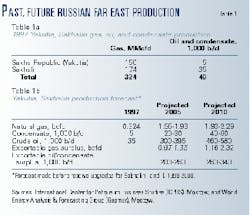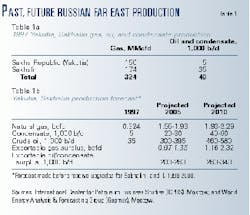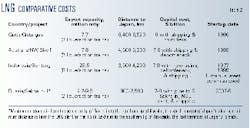About this series
This article concludes a two-part series prepared as part of a study of Japanese energy security for the James A. Baker III Institute for Public Policy, Houston, with support from the Center for International Political Economy, New York.
As Japan readies to increase its natural gas use, the country must consider how best to transport additional gas to its consuming centers.
This final part of a two-part series examines cost considerations most economically to transport gas from the Russian Far East to Japan, whether by pipeline or LNG. Part 1 analyzed the relative economics of transporting Sakhalin gas by pipeline vs. LNG or competing LNG suppliers.
Although the energy-security focus of Japan's politics has kept the Russian Far East alive as a commercially viable hydrocarbon supplier for more than 3 decades, the commercial success of the region has looked dismal until recently.
In the Russian Far East, Sakhalin Island has emerged as the leading low-cost supplier, either by pipeline or LNG.
Unsuccessful projects
Japanese companies have been attempting to develop oil, gas, and coal reserves in the Russian Far East (as well as East Siberia) for 30 years.
In the 1970s, the main focus for gas development was in Sakhalin Island, the Vilyui gas-condensate deposits of Yakutia, and some selected East Siberian gas finds. The East Siberian find in Irkutsk ultimately evolved into the current Kovyktinskoye, or Kovykta, project currently under consideration.
The Japanese experience was disheartening at that time.
The original Sakhalin Oil Development Cooperation Co. Ltd. (Sodeco) consortium was formed under the aegis of Japan National Oil Corp. (JNOC) and involved a large number of Japanese trading houses and refiners. Although the consortium linked forces with a major international oil company, Gulf Oil Corp. (taken over by Chevron, then Standard Oil of California, in 1984) as far back as 1972, it never reached any concrete planning stage.
The reasons for the failure of the consortium vary.
The Soviet Union delayed granting permission to proceed with field development, while Moscow asked Japanese companies to carry most of the Soviet share of project development costs.
A shortage of hard currency on the Soviet side led to payment through barter. Japanese companies and large diversified trading houses found that counter trade offerings of raw materials-mainly timber, minerals, fish, and furs-were of uncertain quality, often delivered behind schedule, and sometimes damaged in transit.
Finally, the Soviet Union's invasion of Afghanistan in 1979 led to a total freeze of Japanese trade and development credits. In response, Moscow put all joint development projects on indefinite hold.
A second Japanese project was a proposal to develop the gas and condensate reserves of Vilyui with US gas company El Paso Energy Corp. (now El Paso Corp.). This project was first the ill-fated "North Star" LNG project. Later, this proposal was for a gas pipeline from Yakutia to Japan.
Besides these projects, the Japanese had small Russian project proposals, including studies for gas and oil developments in East Siberia.
Revival of projects
After hundreds of millions of dollars in investment and efforts for almost 20 years, the Russian Far East yielded little commercial value to Tokyo.
The maximum oil exports from that region to Japan never exceeded 70,000 b/d. Most of this volume came from long-operating wells in onshore Sakhalin. By the end of Soviet Russia in 1989, all Japanese-sponsored oil and gas projects were essentially dead.
South Korean companies initiated the next chapter in energy developments in the Russian Far East. Seoul oddly enough revived interest in gas development in the region by beginning a feasibility study in 1993 to develop the Kovykta (Irkutsk) gas and condensate reserves.
In 1995, China for the first time indicated that it would be interested in pipeline natural gas imports. It signed preliminary accords with the Russian government and Russian companies to study these development proposals further.
In the mid-1990s, Japanese commercial interest in Sakhalin was revived, resulting in two of three Sakhalin production-sharing agreements (PSAs) under current implementation. The three existing programs include: Sakhalin-I, led by Exxon Corp. (now ExxonMobil Corp.); Sakhalin-II, led by Royal Dutch/Shell; and Sakhalin-III, led by Mobil Corp. (now ExxonMobil).
Sakhalin-III currently has no Japanese participation. It consists of ExxonMobil, Texaco Inc., and several Russian companies.
As discussed in Part 1, producers of Russian fields will handle condensate sales from the Russian fields before gas sales. Both Shell in Sakhalin-II and ExxonMobil in Sakhalin-I concentrated initially on production of liquids, including black oil.
Tables 1a and 1b show current oil and condensate production from Yakutia and Sakhalin and the forecast for future production of natural gas, oil, and condensate.
Increased gas use
Several factors may promote increased gas use in Japan: a deregulated electricity market, the demise of the nuclear industry, the Kyoto agreement, and an increasing number of suppliers.
As Japanese electricity markets are increasingly deregulated, economic incentives for gas use may increase. Increasingly, Japanese utilities no longer can automatically pass on fuel costs to final consumers, making energy efficiency a prime concern.
In some sectors, use of gas can provide higher efficiencies than oil. For example, combined-cycle gas turbines for power generation are more efficient than conventional steam-based, thermal plants based on direct burning of crude oil.
The country's continuing spate of nuclear plant mishaps has kept environmental issues high in public consciousness. They cast doubt on the ability of the Japanese government to complete its current nuclear power plant construction program.
Moreover, the Kyoto Accord is taken seriously in Japan and efforts to reduce emissions will lead to a favoring of gas over oil for power generation. It is likely that natural gas use will be a major beneficiary of the Kyoto agreement, particularly if nuclear energy expansion plans cannot be implemented because of safety concerns and popular opposition.
New emerging supplies are also refocusing attention on gas' potential. In recent years, there have been large gas discoveries in the Asia Pacific, in Malaysia, Indonesia, Australia, and Papua New Guinea. At the same time, new LNG projects have been proposed from the Middle East.
The collapse of the Soviet Union sparked renewed interest in developing the gas and crude oil reserves of nearby Sakhalin and the Russian Far East.
The increasing instability seen in Indonesia, previously thought of as the most secure gas supplier to Tokyo, has refocused efforts on alternative gas suppliers. The increase in the number of competing suppliers is lowering prices for LNG, opening the prospects of new, cheaper suppliers in the coming years.
Pipeline capital costs
Japan's supplier choice will likely depend on the lowest cost supplier. A pipeline from the Sakhalin fields is the leading contender, although one from either the Vilyui or Kovykta fields is not out of the question.
Imports of LNG from Indonesia, Australia, Qatar, and the Sakhalin fields will compete with such pipelines, if built.
Capital costs for gas pipeline projects center on four major factors:
- Cost of field development.
- Length and capacity of the transmission line and route.
- Type of pipeline, such as one highly pressurized or designed for a specific climate or terrain.
- Size and sophistication of the receiving market.
Field development
Capital costs in field development vary extensively, depending on the nature of natural gas reservoirs, the size and sophistication needed in gas gathering facilities and gas-treatment plants, the distance from support bases, and the terrain and climate.
Although costs vary widely, all fields for the inland gas finds of the Russian Far East have substantial development costs.
Exploration and development (E&P) costs for Sakhalin-I totaled $475 million through 2000. Costs for Sakhalin-II reached $1.25 billion by the end of 2000. Once gas field preparation is added to the preliminary costs of getting oil and condensate production online, both projects will separately cost $1.4-1.8 billion, possibly more.
The financial commitment made by the Sakhalin-III group simply for exploration is at least $353 million. If discoveries are made and prove commercial, total E&P costs will exceed the costs of Sakhalin-I and II because the PSA block is in deeper water and more difficult exploration conditions.
Transmission line, route
Capital costs for a major transmission line from the various fields differ substantially.
Sakhalin projects have an inherent advantage because the island is a neighbor to Japan. Even in this case, the trunkline must stretch 850 km to reach Hokkaido, the northernmost Japanese home island, and 1,500 km to reach central Honshu, the heartland of Japanese gas demand.
Comparatively, a southwest pipeline to Shenyang in northeast China would stretch a minimum 2,400 km. It would be 3,500-4,500 km away from large urban centers in eastern coastal zones that could absorb sufficient gas volumes.
These Sakhalin-to-Japan options range from $950 million to $1.4 billion for a 42-56 in. (1.07-1.42 m) pipe depending on landfall in Japan. This estimate excludes the cost of laying a domestic gas transportation system, itself a multibillion dollar undertaking.
Sakhalin sales to China would cost substantially more. The cost of a major trunkline from Irkutsk to China, South Korea, and possibly Japan (3,340-6,800 km) is from $6.0-14.5 billion, depending on whether a route traversing Mongolia is used and whether Japan is the primary sales target.
Estimates for a Vilyui pipeline (5,500-6,500 km), again using a standard 42-56 in. pipe, also range from $6-15 billion, depending on the final market destination and length. The cost for a two-train LNG project, with each train of 2.5-3 million tonnes/year (tpy), would be $2.5-4 billion, excluding upstream costs and tankers.
Total costs for an LNG project in Sakhalin-II could reach $7-8 billion. Table 2 shows comparative costs for LNG projects from various locations.
More realistic cost estimates require that the estimator first establish Japan as the top export market priority and second consider how Japan can reduce the delivered cost of gas once supply reaches landfall on one of Japan's major islands.
Type of pipeline
A high-pressure line can reduce capital operating costs considerably. According to figures from Agip, a division of ENI, carrying costs for a 1,000 km, high pressure, 56-in. pipe with a daily flow of 2.9 bcfd would be $0.22/MMbtu. The same pipe carrying low-pressure gas costs $0.31/ MMbtu. Pressure and pumping rates im pact both capital and operating costs.
Capital costs can increase by 30-40% for the same length of pipe if accommodations are necessary to fit specific climates. The climatic conditions of the Russian Far East require that certain portions of the line be armored and heavily insulated or suspended (like the Trans Alaskan Pipeline System) above frozen tundra to minimize environmental impacts.
Even with new and efficient pipelaying techniques, pipeline capital costs rise when pipe is laid offshore. Pipelines approaching Japan from the west must deal with the enormous depths of the Sea of Japan marine trench or route around it. Although Sakhalin-based pipelines can avoid this difficulty, all offshore pipelines will be costly.
If targeted for a Japanese market, offshore pipelines must take costly precautions to prevent pipeline rupture from undersea seismic disturbances and withstand Japan's regular earth tremors.
Size, sophistication of market
The size and sophistication of the receiving market and the extent of the national distribution reticulation system also play a part in capital costs. The buyer of the gas, however, generally assumes these costs, not the seller.
Japan has by far the largest and most sophisticated gas market of the three potential export countries considered. The question remains as to what Japan will do to expand that market.
The foremost decision that must be made soon is the construction of a national gas-transportation network. This would not only knit together the two major gas-consumption areas-the Kanto plain surrounding
Tokyo and the Kinki region surrounding Osaka and bordering the Inland Sea-but it would also make possible gas movement from a pipeline landfall point to major consumption areas.
Costs for such a national transmission system are high, $7-10 billion, for a minimum linkage of the Kanto and Kinki regions to a pipeline landfall point.
Reducing the cost of moving gas domestically is a prime consideration for any export pipeline to Japan. The decreased cost in domestic distribution would benefit LNG imports as well, which for the most part are restricted to beachhead areas, close to end users.
Other profitability factors
Outside of capital cost for pipelines, Japan must consider business and environmental factors, inherent to the region or field, in evaluating the profitability of gas pipeline or LNG projects.
These factors include transfer prices, flow and sales volumes, NGL sales, LNG purchase models, and the impact of independent power production (IPP) projects.
- A major factor in the economics of gas projects is the transfer price of field gas to the consortium selling that gas to export markets. Wellhead gas-sales prices to the consortium must be low enough to attract buyer interest but high enough to allow for a commercial rate of return on project capital.
If Russian Far East interior wellhead prices are $0.50-0.80/MMbtu, most development consortia believe that supply can be delivered at market-related prices. Yet some estimates for minimum wellhead prices range far above this level, as much as $1.10/MMbtu. Most LNG projects are based on wellhead gas prices in this range.
While Russian officials, guarding the economic interests of the host country, may believe that $1.10/MMbtu is too low, raising wellhead price levels substantially above that level may scuttle export projects before they get off the ground.
For Russia, the benefit will not be high gas prices but employment, tax revenues, hard currency earnings, and infrastructure spin-offs.
- Project evaluations must consider the minimum flow and sales volume needed to initiate a gas development.
Most interior pipeline proposals assume that the initial phase of development would have a minimum delivered gas capacity of 1.2 bcfd followed by a second phase of equal size.
The flow for a two-train 9 million tpy LNG project for Sakhalin, delivered gas per each 5 million tpy train would be about 660 MMcfd, depending on conversion loss and distance to market.
To export such large gas volumes, developers must lock in major gas-buyer commitments before developing the field. The volumes of gas needed simply to fill any of these pipeline projects are enormous, ranging 0.2-1.0 tcf, depending on distance, pressure, and pipe diameter.
- Another economic factor in weighing gas-project profitability is the presence of NGLs. In this regard, all Russian gas proposals are relatively fortunate, as reserves contain considerable volume of both LPG and condensate.
Yet most pipeline projects, based on reserves far in the interior of the Russian Far East, have only limited domestic markets for LPG or condensate sales. Once immediate market needs are satisfied, these liquids must be transported substantial distances for incremental sales.
Only Sakhalin has relatively easy access to large-scale markets for low-cost export of NGLs.
- The traditional Japanese LNG model emphasized long-term buyer commitments, relatively high delivered cost for gas supply, careful long-range planning for production, buyer offtake commitments, and financing.
The model began to break down in the mid-1990s when South Korean buyers demanded-and were conceded-substantial changes in the purchasing accords first with Oman, then with Qatar.
The seller abandoned ceiling and floor price limits, allowed the buyer to provide its own LNG transportation, and modified the pricing formulas from the Japanese model.
Korea Gas Corp., the monopoly LNG importer for South Korea, was allowed a direct participation in all phases of the LNG consortium supply gas sales.
It is implicitly acknowledged in Japan that the old way of conducting the LNG business is dead, but what will replace it?
While Japanese LNG buyers are unsure of the final form of new LNG purchase contracts, they are clear on what issues the model should address. The new model LNG accord must cut delivered-gas cost, increase supply and pricing flexibility, and take into account substitution cost competition for end users.
The justifications of "non-economic" factors, such as security of supply or LNG's "green premium," no longer outweigh the competitive force of lower costs for alternative fuels.
Japanese buyers, using their substantial market weight, are demanding LNG contract terms at least equal if not more favorable, to those already granted to South Korea. This round of "clawback" contracts began in 1998 and will continue as contracts come up for renewal through 2003.
A more proactive move is the Japanese push for shorter term contracts and a mix of short-term (1-2 years) and medium-term obligations (3-5 years) to complement their baseload 20-year term contracts.
After once opposing shorter-term buyer obligations, Japanese buyers, under the twin pressures of deregulation and convergence, are beginning to see the benefits of less expensive, shorter-term contracts outweighing supply security concerns.
Flexibility in pricing and in offtake volumes will increasingly become the norm for the new model Japanese LNG contract.
- Finally, the development of IPPs in Japan has opened the door for the first fully vertically integrated power project in Japan.
Owning a fully integrated LNG-to-power vertical supply chain allows a company to develop gas finds into an LNG project, sell and transport LNG to its own power subsidiary, and sell electricity generated by that plant.
So far, no company has completed a fully integrated LNG-power project. While a grand idea, the concept will be difficult to implement.
Several Japanese companies, both utilities and trading houses, however, have begun to lay plans. Enron Corp. has announced a project to build Japan's first LNG-based IPP.



